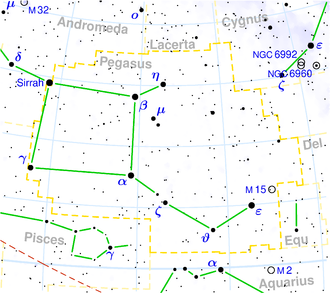NGC 7769
| Galaxy NGC 7769 |
|
|---|---|
![NGC 7769 [1] SDSS image](https://upload.wikimedia.org/wikipedia/commons/thumb/b/b0/NGC7769_-_SDSS_DR14.jpg/300px-NGC7769_-_SDSS_DR14.jpg)
|
|
| NGC 7769 SDSS image | |
| AladinLite | |
| Constellation | Pegasus |
|
Position equinox : J2000.0 , epoch : J2000.0 |
|
| Right ascension | 23 h 51 m 03.97 s |
| declination | + 20 ° 09 ′ 01.5 ″ |
| Appearance | |
| Morphological type | (R) SA (rs) b / HII / LINER |
| Brightness (visual) | 12.0 mag |
| Brightness (B-band) | 12.8 mag |
| Angular expansion | 3.2 '× 2.7' |
| Position angle | 170 ° |
| Surface brightness | 14.2 mag / arcmin² |
| Physical data | |
| Affiliation | WBL 726 NGC 7771 group LGG 483 |
| Redshift | 0.014046 ± 0.000007 |
| Radial velocity | 4211 ± 2 km / s |
|
Stroke distance v rad / H 0 |
(195 ± 14) · 10 6 ly (59.9 ± 4.2) Mpc |
| diameter | 180,000 ly |
| history | |
| discovery | William Herschel |
| Discovery date | September 18, 1784 |
| Catalog names | |
| NGC 7769 • UGC 12808 • PGC 72615 • CGCG 455-054 • MCG + 03-60-030 • IRAS 23485 + 1952 • KUG 2348 + 198A • 2MASX J23510396 + 2009014 • Mrk 9005 • GC 5020 • H II 230 • h 2274 • GALEX ASC J235103.91 + 200901.9 • LDCE 1598 NED001 • HOLM 820C • KTG 82A | |
NGC 7769 is an active spiral galaxy with extensive star formation regions of the Hubble type Sb in the constellation Pegasus in the northern sky . It is estimated to be 180 million light-years from the Milky Way and about 105,000 light-years across. Together with NGC 7770 and NGC 7771 , it forms the galaxy trio Holm 820 or KTG 82A and is a member of the NGC 7771 group ( LGG 483 ).
The Supernova SN 2019iex was observed here.
The object was discovered on September 18, 1784 by the astronomer William Herschel .
Web links
Commons : NGC 7769 - collection of images, videos, and audio files
- SIMBAD Astronomical Database
- Aladin Lite
- Spektrum .de: amateur recordings [1] , labeled map of the area
